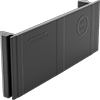Filter by
Material
Reinforcement Material
Thickness
Color
Performance
Flexibility
Clarity
For Use With
Hardness Rating
DFARS Specialty Metals
Panel Material
Blade Material
Raw Materials
Building and Machinery Hardware
Safety Equipment
Containers, Storage, and Furniture
Heating, Ventilation, and Air Conditioning
Material Handling
Electrical
Communication
Fluid Handling
Facility and Grounds Maintenance
Lighting
































































































